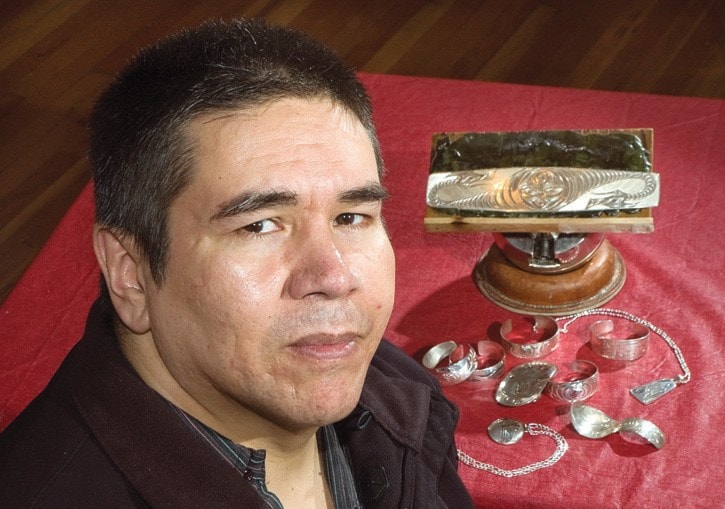Good artists aren’t just born, nor are they made.
They are a combination of hard work and talent. Leslie Wells is all this and something more.
His hereditary Salish culture as well as his determination to develop his gift make him one of the leading lights in First Nations art today.
A few days ago, we sat down with Leslie and his mother, Eleanor, to talk about his life and art.
Born in 1961, he grew up on the Semiahmoo First Nation reserve where his grandfather, Bernard Charles Sr., was the band chief.
As a young boy, every spare moment was spent creating intricate drawings. Unfortunately, none of them survive today, but Leslie smiles as he remembers that one of his favourites was of Alice in Wonderland and a guitar-playing caterpillar. For an elementary-school science project, rather than copy images out of a text book, he illustrated the text himself.
The teacher was so impressed, he kept the project to use as an example for other students.
After Peace Arch Elementary, Leslie attended Earl Marriott Secondary, where he made the senior rugby team in his initial year.
His mother suggests that was a defining experience for him.
“Leslie is very disciplined. I believe that comes from his early years in sports.”
Leslie received his first formal training at the age of 20, when he enrolled in a silkscreen-printing course at the Native Education College in Vancouver. After the course, he began to concentrate on drawing Salish designs.
“I just learned how to draw my own Salish style of art. I developed my own select style.
“I would go to libraries and look up old Salish designs and try to copy them. Often I’d stay up all night just drawing. You have to apply yourself to get good at it. A lot of people think it comes naturally, but you really have to work at it.”
Early in his career, he got some help from a prominent source.
“I really didn’t know what category Salish was in, or what style of art it was. Robert Davidson gave me a copy of one of his books, Haida Printmaker, and I began drawing out of that.”
In the late 1990s, Davidson approached the Semiahmoo Band looking for apprentices to help him with “The Gift”, a monument to commemorate the 125th anniversary of the RCMP.
Both Leslie and his brother, Leonard, apprenticed with Davidson from 1998 to 2002. Leslie helped carve the Salish house post and Haida totem pole which now stand on White Rock beach.
“Robert taught me artistic freedom, the freedom to do whatever you want to do as an artist. I do what I want to do, and don’t even think about what other people think, as long as I’m happy with what I do.”
Dave Bell, an artist from Alert Bay, encouraged Leslie to work with silver.
In February 2008, Leslie graduated from the Northwest Coast Jewelry Arts Program at the Native Education College in Vancouver. Silver jewelry is now Leslie’s main medium, but by no means his only one.
As part of the Surrey Public Art Program, Leslie and Leonard collaborated on “Elder Moon and Under the Double Eagle,” a large double-sided cedar disk which stands at the roundabout at 20 Avenue and Rotary Way in South Surrey.
Leslie has done other works for this program, including a welcome figure in North Surrey.
When asked if he considers himself a traditional artist, Leslie replies, “Yes, I use traditional designs. There weren’t very many Salish artists earlier, but there are quite a few now. Ten or 20 years ago, there were a lot of artists but they weren’t traditional, they used northern designs.
Now a lot more are going back to the Salish traditional designs.”
Leslie feels he will continue to work in silver, and would like to work with sandblasted glass in the future.
He sells most of his silverwork to friends and family, and through galleries in Vancouver.
An unassuming, good-natured man of very few words, Leslie’s quiet dedication to his craft has led to well-deserved accomplishment and acclaim.
The Peninsula’s best-known mother-and-son historians, Lorraine and Hugh Ellenwood, are dedicated to preserving history through the White Rock Museum & Archives. Call 604-541-2222, or email whiterockarchives@telus.net
